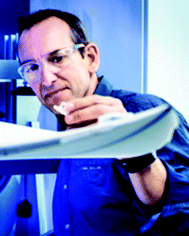Hydrogel properties and applications
Jun
Fu
 a and
Marc
in het Panhuis
a and
Marc
in het Panhuis
 b
b
aPolymers and Composites Division, Ningbo Institute of Materials Technology and Engineering, Chinese Academy of Sciences, 1219 Zhongguan West Road, Ningbo 305201, China. E-mail: fujun@nimte.ac.cn
bSchool of Chemistry and Molecular Bioscience, ARC Centre of Excellence for Electromaterials Science and Australian Institute for Innovative Materials, University of Wollongong, Wollongong, NSW 2522, Australia. E-mail: panhuis@uow.edu.au
Hydrogels are a family of bio-inspired, bio-mimetic, and bio-functional materials with crosslinked hydrophilic networks and high water contents. The chemistry, structures, and functionalities of hydrogels can be manipulated to be employed in potential applications such as drug delivery, shape morphing, shape memory, soft actuators, sensors, artificial muscles, soft robotics, and tissue engineering (to name but a few). Increasingly, these fascinating materials have sparked the interest of many researchers, resulting in a boom in papers dedicated to hydrogels. It is well-known that most conventional hydrogels are weak due to the inhomogeneous distribution of the network and crosslinks. The lack of an energy dissipation mechanism makes them brittle and fragile upon mechanical loading. There has been a long time need to devise toughening and energy dissipation mechanisms to improve the strength, toughness, and fatigue resistance of hydrogels. For example, hydrogels with responsiveness, conductivity and bio-activity have been prepared by incorporating different functional groups or bioactive species. Recently, strategies have been developed to fabricate hydrogel devices and device components with precise control over the structures and properties towards the practical applications. In this themed issue, we present a collection of advances in research on hydrogel properties and their applications.
The invention of strong and tough hydrogels is a breakthrough in the history of hydrogel materials. Since the early tough double network hydrogels, slide-ring hydrogels, and nanocomposite hydrogels, numerous efforts have been devoted to improve the mechanical strength and toughness of hydrogels through elegant design of network structures and energy dissipation mechanisms. One major strategy is to introduce non-covalent interactions, including (but not limited to) electrostatic interactions, multivalent coordination, hydrogen bonding, hydrophobic association, and supramolecular recognition, in the networks that undergo reversible damage and recovery during loading and unloading. Such general strategies have been widely applied to improve the strength and toughness of natural polymer hydrogels for biomedical applications. Groll et al. (DOI: 10.1039/c8tb02575d) demonstrate a control over the crosslinking efficiency and mechanical properties of hydrogels crosslinked by thiol–ene click chemistry. In the full paper by Chen et al. (DOI: 10.1039/c8tb02445f), double network (DN) hydrogels comprised of regenerated silk fibroin (RSF) and hydrophobically associated polyacrylamide (HPAAm) networks are prepared. Both the first RSF and second HPAAm networks are crosslinked through physical associations. The DN gels show outstanding strength and toughness, and rapid self-recovery at ambient temperature. Lu et al. (DOI: 10.1039/c8tb01664j) even intercalate the mussel-inspired dopamine oligomer into gelatin methacryloyl (GelMA) to form additional sacrificial physical crosslinking in the network to yield tough and resilient hydrogels. Supramolecular interactions have been widely introduced into hydrogel networks as energy dissipating mechanisms. In the full paper by Burdick et al. (DOI: 10.1039/c8tb02593b), DN hydrogels are prepared by combining the supramolecular guest–host (GH) hyaluronic acid networks and covalent networks of acrylated poly(ethylene glycol) modified fibrinogen (PEG–fibrinogen) and PEG diacrylate. The dynamic GH interactions enable tunable properties of the hydrogels for the repair of viscoelastic tissues. Moreover, Bian et al. (DOI: 10.1039/c8tb02021c) integrate multi-valent host–guest interactions as reversible crosslinks into biomimetic hydrogels to manipulate the gelation rate, energy storage and dissipation, tensile hysteresis, and fast recovery. Critical roles played by macrocyclic host–guest interactions in the mechanical properties of hydrogels have been comprehensively reviewed by Wang et al. (DOI: 10.1039/c8tb02339e). Natural polymers with abundant functional groups and hydrogen bonding capabilities represent an important family for hydrogels for diverse biomedical applications. Wan, Ma et al. (DOI: 10.1039/c8tb02331j) review multifunctional cellulose-based hydrogels for biomedical applications ranging from drug delivery to tissue engineering, wound dressing, bioimaging, and wearable sensors. In contrast to the progress in tough hydrogels, the mechanisms behind the exciting experimental findings are yet to be explored. It has been difficult to track the gelation and deformation of hydrogels at the molecular chain level. Molecular dynamics (MD) simulations are powerful computational methods used to understand a lot of experimental observations. Díaz Díaz et al. (DOI: 10.1039/c8tb03036g) review the current state-of-the-art in MD studies on the gelation processes and the mechanical properties of hydrogels.
Self-healing is very important for many applications. There has been great enthusiasm to create healable materials, including polymer elastomers and hydrogels, for potential applications in maintenance-free circumstances. The key relies on the re-establishment of the damaged bonds or structures after damaging. Reversible bonds have been demonstrated successful for this purpose. Self-healing hydrogels have been extensively reported based on, for example, hydrogen bonding, host–guest interactions, hydrophobic associations, and dynamic bonding. Ren et al. (DOI: 10.1039/c8tb02547a) review the recent progress in self-healing hydrogels based on host–guest interactions, particularly focusing on hosts of macrocyclic cyclodextrins and cucurbit[n]urils with various guests. Okay (DOI: 10.1039/c8tb02767f) reviews other strategies based on semi-crystalline nanodomains as physical crosslinks to establish dynamic networks that exhibit melt processibility, self-healing, and shape-memory functions. Such mechanism opens up several applications including injectable hydrogels, chemical motors, and 3D/4D printing. Bettinger et al. (DOI: 10.1039/c8tb02854k) introduce a self-healing hydrogel based on the multivalent coordination of catechol–Fe3+ coordination. The gelation kinetics and self-healing are dependent on the valency and redox potential of the metal ions and thus could be manipulated through electrochemical mediation.
Shape morphing materials are promising for applications such as soft robotics, actuators and artificial muscles. Responsive hydrogels with functional groups sensitive to, for example, pH, temperature, light, electric field, and magnetic field, have been widely reported. As the outstanding mechanical properties and self-healing provide stability of the materials, well-defined structures and functionalities are essential for programmable morphing routes. Guo et al. (DOI: 10.1039/c8tb02585a) construct thermo- and water-responsive hydrogels based on cooperative hydrogen bonding and hydrophobic association in a polyurethane–urea supramolecular network. Dynamic covalent bonds are integrated to impart pH responsive degradation while azobenzene moieties are used to endow UV-vis controlled stiffness. Similar multi-modal strategies have been increasingly developed to produce multi-responsive multi-functional responsive and shape morphing materials. The orthogonal mechanisms even enable independent manipulation of the hydrogels. Wu et al. (DOI: 10.1039/c8tb02896f) demonstrate the fabrication of photo- and thermo-responsive composite hydrogels with precisely defined heterogeneous structures by photolithographic polymerization. The periodic distribution of responsive patterns throughout the hydrogels motivates programmable shape transformations upon sequential stimuli. By spatially patterning plasmonic nanoparticles into thermal responsive hydrogels, Nie et al. (DOI: 10.1039/c8tb01959b) combine the photothermal heating of the nanoparticles and thermoresponsiveness synergistically to motivate different modes of shape deformation upon light irradiation. Ionov et al. (DOI: 10.1039/c8tb02579g) systematically review the most recent progress in shape-changing polymers for biomedical applications, including the mechanical properties, processing techniques, fabrication, and most appealing applications of the intelligent materials. Currently, most shape morphing devices are fabricated by approaches such as multi-step synthesis, photolithography, and additive manufacturing (3D/4D printing). It remains a challenge to invent convenient, facile and efficient methods to integrate different materials into single sophisticated devices. Shi et al. (DOI: 10.1039/c8tb02588f) demonstrate the macroscopic supramolecular assembly (MSA) of rigid hydrogels. The key is to create a flexible spacing coating containing host or guest moieties that form supramolecular recognition at the interface. The concept of MSA may illuminate new ideas to fabricate multi-materials and multi-functional hydrogel devices.
Well-known as bio-mimetic and bio-functional materials with high water content and biocompatibility, hydrogels have been long used as tissue engineering scaffolds. The diversity in tissues and organs in terms of mechanical properties, structures, bio-functionalities and physiological functions requires a broad manipulation of the structures, properties, and functionalities of the scaffold materials. Hydrogels are advantageous over most other materials for their flexibilities in chemical, physical, and biological properties to meet diverse demands. Injectable hydrogels containing biomolecules, drugs, and even cells are injected into target tissues with minimal invasion. Applications of such injectable hydrogels for heart failure therapy have been reviewed by Zhao, Jin et al. (DOI: 10.1039/c8tb02591f). For load-bearing tissues, on the other hand, adequate strength and toughness are needed to match the host tissues. Articular cartilage tissue engineering, for example, has been most challenging for the avascular nature and load bearing properties. Conventional hydrogel scaffolds usually fail due to the lack of adequate mechanical support although some of them nicely promote chondrogenesis of stem cells and formation of new cartilage-like tissues. New strategies have recently been employed to augment the strength and toughness of biofunctional hydrogels. In the full paper by Hutmacher, Meinert et al. (DOI: 10.1039/c8tb02607f), GelMA hydrogels reinforced with microfibre scaffolds are used to encapsulate chondrocytes for cartilage tissue engineering. The mechanical and chemical properties have to be precisely controlled to avoid cytotoxicity for preclinical applications. For the fabrication of complicated scaffolds, novel manufacturing methods including 3D printing are involved. Hydrogels are ideal inks for 3D bio-printing, particularly as cells are needed for the scaffolds. Jang et al. (DOI: 10.1039/c8tb02787k) develop an islet-laden pancreatic tissue-derived extracellular matrix bioink and printed biomimetic 3D constructs to enhance the pancreatic functions.
The interfacing of hydrogel biomaterials and tissues is of special interest for in vivo applications. Hydrogel coatings have been utilized to impart softness at the implantable medical device interface, deliver therapeutics and control cell interactions. Green et al. (DOI: 10.1039/c8tb02763c) review the application of hydrogels to neural bio-electronics. The design of hydrogel systems with proper mechanical, chemical, and biological properties is critical for the soft coatings of implantable medical devices. Although most conventional hydrogels are non-adhesive due to the highly hydrated hydrophilic chains, recent reports on adhesive hydrogels have opened up new applications of hydrogels. Jeong et al. (DOI: 10.1039/c8tb02598c) prepared bio-inspired hydrogel adhesives for wet and underwater surfaces by fabricating periodic arrays of micropillars of hydrogels. Alternatively, mussel-inspired adhesion has illuminated broad research interest on 3,4-dihydroxyphenylalanine (DOPA)-functionalized hydrogel bioadhesives. Wang et al. (DOI: 10.1039/c8tb01990h) modify chondroitin sulfate (CS) with DOPA groups to produce hydrogels as a bioadhesive for multiple internal medical applications. In contact with wounds, soft and adaptive hydrogels offer cellular niches that may promote healing. Zheng, Wu et al. (DOI: 10.1039/c8tb02590h) demonstrate the improved cutaneous wound healing by using zwitterionic poly(sulfobetaine methacrylate) hydrogels with optimal mechanical properties.
This themed issue on hydrogel properties and applications aims to present some important directions of this rapidly developing area for scientists, engineers and medical professionals. The comprehensive reviews and original research articles provide not only the updates, but also the challenges and perspectives of hydrogel research. We envisage that this themed issue will inspire the interested readers to develop new ideas for research on hydrogels and their applications.
We are grateful to all the contributors for the outstanding papers, and the Royal Society of Chemistry and Journal of Materials Chemistry B for making this themed issue available to our readers. Finally, we hope that you enjoy the articles in this themed issue as much as we do!
| This journal is © The Royal Society of Chemistry 2019 |


